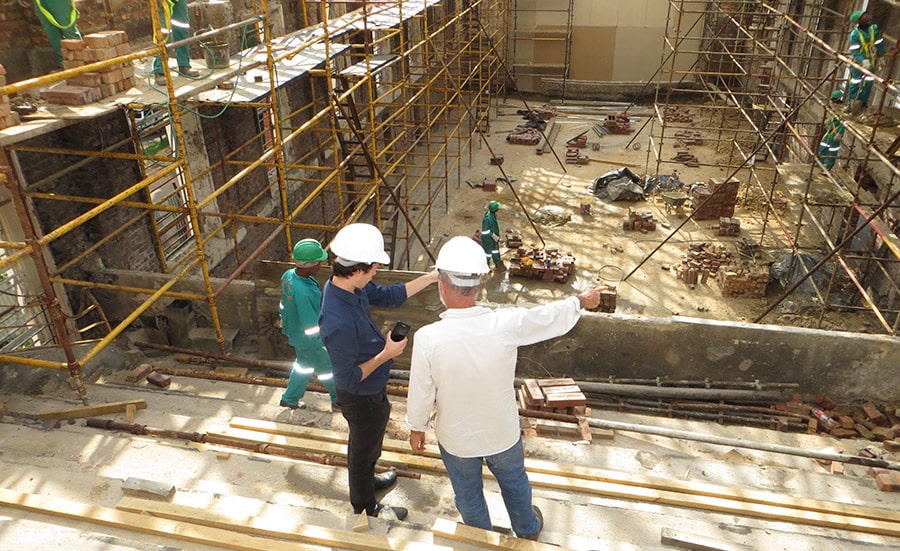Your guide to who does what in construction


Whether it be a commercial business park, residential estate or city high-rise, there are a pretty standard set of stakeholders in construction projects, all with their own responsibilities.
Sometimes it’s hard to tell what those responsibilities are, especially when it comes to head contractors vs subcontractors.
At the very head of a commercial construction project though, is the client. Clients can come from any background from property development to corporate business.
Depending on the project, they might put out a tender where they may be seeking one head contractor to take on the job to then outsource to subcontractors (the guys who do all the work).
The client will also typically allocate someone on their side to manage the project as a whole and liaise with the head contractor to make sure everything runs smoothly.
Each stakeholder in a commercial construction project has its own roles and responsibilities. If you’re a subcontractor looking to transition from private residential jobs to the big league in commercial construction, you’ll need to know who does what.
Of course, at the very centre of the project is the client. On that side of the fence, you’ll have your client side project manager.
A client side project manager is chosen by the client and is the sole point of contact (to the client) for the head contractor on a construction project. Both the client side manager and the head contractor will liaise regularly to make sure all elements of the project are done right and on time. Their job is to make sure that everything is done in the client’s best interest.
More often than not, these guys are ex-head contractors so they know what they’re doing and what to expect. This person is responsible for tasks such as:
Having a client side project manager makes it much easier to have one source of truth. The more people with their hands in the pie on the client’s side, the more confusion for the head contractor and the subbies below them.
This person is in charge of steering the ship so to speak.
Head contractors otherwise known as the head builder, are the on-site head honchos. Usually, the head contractor has been chosen as the construction contractor after a tender process.
More often than not, it will be a commercial builder with a fair amount of projects under their belt.
After winning a tender, the head contractor is then responsible for sourcing all the subcontractors. The subcontractors then will often source suppliers to fulfil the work requirements.
During the project, head contractors are responsible for all the work that isn’t part of the actual building itself, such as:
Head contractors are responsible for making sure everything is done right, safely and to the client’s satisfaction.
Most head contractors who win the big jobs have done it many times before, so they will have pretty tight processes and knowledge of the ins and outs of a commercial construction project.
Last but not least, subcontractors. Subbies might be lower on the food chain when it comes to a big construction project, but we all know who does all the hard labour right?
A lot of subcontractors start off in smaller private projects. Depending on your taste for success or money, it’s always worth dabbling in commercial projects that come about through tenders.
Typically the head contractor will outsource a lot, if not all of the trades (subbies know their stuff better than anyone).
These projects could be a new high-rise in the city or a brand new estate of residential townhouses. You’ve got plenty of options. It’s worth keeping an eye out on the construction tenders we have available for you to quote on.
Sometimes you might also be asked to provide a quote for a project. If you’re unsure what is required for this, don’t worry, we can help equip you with the skills to prepare a quote for your next construction project.
The nominated subcontractors on a commercial construction process may have gone through a tender process themselves and cover everything from plumbing to security and communication systems.
As a subbie, you’ll need to:
The head contractor heads the project and wil guide everyone in the right direction, but overall, you’re the master of your trade.
There are endless opportunities for a subcontractor to get their hands on a bigger job. It’s really just about getting yourself out there and in front of the head contractors more often.
Have a look at our article on improving your chances of winning a tender to make sure you put your best foot forward for the next tender.

It’s safe to say, paperwork is not the most thrilling part of any profession. Let’s be honest, writing quotes for tendering builders isn’t something you’d write home about.
You’re probably thinking though, what exactly is a tender and what do I need to do? Don’t stress, we have the answers.
A tender is a formal opportunity for businesses or suppliers to submit a written offer (tender response), including costs, timelines and more, to complete work set out by a client. The work can be for anything from a large scale construction project to provision of marketing services for a corporate brand.
The most common tenders you will see will be construction tenders and commercial construction tenders. As no two jobs are the same, you can’t simply just copy and paste the same price from the last job. The thousands of moving parts in a construction project needs serious attention at every angle.
Tender responses include the who, what, when, how and everything else in between. Meaning, yes, they do require a bit of extra work (that, unfortunately, isn’t paid), but it can be worth it in the end for that big payday.
You’ll probably regularly see different terms are thrown around when it comes to tenders.
Terms such as:
All of these are similar in nature but for the most part, you’d be more likely to receive a Request for Tender or Request for Quote.
For a more comprehensive breakdown of construction tendering terminology, check out our construction terms 101 article
You might get an expression of interest (EOI) request before you receive an RFT or RFQ. An EOI is typically the first step in a multi-phase tender process, where you will be requested to express interest in a job set out by a client.
Your response to an EOI can be similar to a tender response, but you’re not required to provide any costings at this point. The client also won’t be selecting the business to do the job at this point.
Think of it as an audition process to show your businesses interest and capabilities to move to the next round.
For a comprehensive guide check out our article on how to bid for construction tenders.
When a client puts out a request for tender, they will provide the requirements of each supplier’s response (or at least as many requirements as they can).
Construction businesses are usually pretty good at providing you with all the information you need for tenders. Sometimes you won’t get much information from other clients though, so you’ll need to provide what you can, based on what they’ve given you.
At a minimum, your tender response would need to include:
Sometimes it also helps to show the team that would be working on it and their experience as well. A lot of businesses these days like to know the professionals behind the job before they make a decision.
Everyone who responds to a tender will be marked against the same criteria. This is why you have to make your answers count. As always, practice makes perfect.
Once a supplier has been formally accepted with their – let’s call it – winning response, a contract is created. It’s not always a quick and easy process to put together a tender response but we’ve got all the tools (and tips) to help you write your best submission for the tenders you want.
There are different types of competitive tenders used across the globe, but the most common types of tenders in Australia are open, negotiated, selective, single-stage and multi-phase tenders.
Open tenders allow anyone to submit their response no matter how big or small, or new they are. It’s a great opportunity for emerging businesses to get their name out there.
Open tenders are the most common type of tenders for the construction and engineering industries. You’ll also see these a lot with government tenders, as they are legally required to go out to everyone.
Given the tender is open to everyone, this tender process is by far the most competitive, meaning you have to have all your ducks in a row to be in the running.
Negotiated tenders occur when a client approaches a single supplier. The client would select this supplier based on previous relationships or their track-record with them. It usually helps them reduce costs too.
This type of tender is quite handy for highly specialised projects or for extending an existing contract with that supplier (do your best and you’ll always get rewarded). Therefore, the negotiation process becomes much easier.
Most public-funded contracts will not use negotiated tendering due to the potential of ‘comfortable’ relationships that can develop, which can exclude other equally qualified suppliers in the process. That means, your connections probably won’t be able to help you get on a government tender panel, but we can.
In a selective tender, the client will send out a request for tender to multiple suppliers that they feel are suitable for the project.A selective tender is similar to a single-stage tender. This could be their top five favourite construction businesses for a specialist or complex contract.
The only downfall to this type of tender is that smaller businesses are usually forgotten and not included in the process. But don’t worry, there’s still plenty of work out there for you if you’re a smaller business.
A single stage tender is usually called on when there is enough information available to them to calculate a realistic price before the process begins. The more traditional route taken by clients is the single-stage tender process.
An invitation to tender is then sent out to prospective suppliers, sometimes after pre-qualification work is done. From there, suppliers can submit their tender response for review and so begins the battle to win the job.
Two-stage tenders, sometimes called multi-phase tenders, are when there is the early appointment of a business to a project before there is enough information for them to fully quote the job.
In Australia, this can also be referred to as early contractor involvement (ECI). It’s typically used by clients who might not have fully fleshed out their plan yet.
For example, to save costs and get it right the first time, a developer may get a construction contractor in early to work with the architects to design the project within budget. Having all parties involved from the get-go means they reduce costs and time in the long run.
After early involvement, once you have everything you need, you’re in a position to offer them a fixed price for the remainder of the project.
There’s a lot of information you need to know for tenders. We know it can be a bit overwhelming, especially if it’s your first time, but that’s why we’re here to give you expert advice and access to all the jobs you could imagine.
If you’re a subbie looking for tenders or resources to help you write your tender responses, we’ve got you. Check out our insights page for some tips and tricks of the trade.